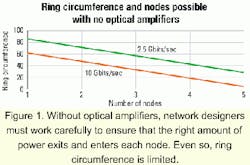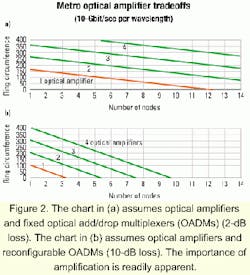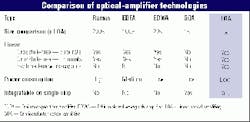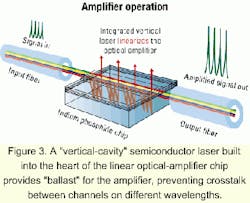LOAs enable next-generation metro networks
Linear optical amplifiers decrease cost and enable the use of unity gain segments.
DR. SOL P. DIJAILI, DR. JEFFREY D. WALKER, and JOHN M. WACHSMAN, Genoa Corp.
The optical network is working its way from the backbone through the metropolitan areas on an inexorable march to the customer premises, where in the not-too-distant future, a fiber may supply each home and office. However, the closer one gets-in the network sense-to the millions of end users, the less cost can be sustained at any node in the network. The profoundly differing economics between the long-haul markets and metropolitan ones demand at least an order of magnitude of price/performance improvement in metro optical components and ultimately much more.
Such dramatic improvements are routine for purely electronic network products, which have benefited from decades of chip-based integration of the active components, in particular the gates and amplifiers. By contrast, however, the optical network has not yielded to chip-based integration in one vital area-that of the optical amplifier. Today, the optical amplifier-particularly the erbium-doped fiber amplifier (EDFA) that revolutionized communications-is a complex optoelectronic subassembly with many fiber splices, tens of meters of erbium-doped fiber, WDM couplers, and up to six individually packaged pump lasers. For typical applications, this combination of components costs from $10,000 to $30,000. The optical amplifier accounts for an amazing 38% of the equipment cost in the long-haul optical network.
Such costs slow deployment of metro optical networks because service providers cannot realize the functionality they need at a price they can afford. Although many of the optical components intended for metro networks are fundamentally scaled-down versions of their long-haul counterparts, the amplifier itself doesn't scale.
And yet amplification is as vital for metro networks as it is for the long haul. Without amplification, the fact that signals weaken will limit the integration of switching, power balancing, processing, and transport. The obvious solution, of course, is to achieve optical amplification with chips-to open the floodgates to further integration. But acceptable chip-based amplifiers have until now defied researchers. The only examples-the so-called semiconductor optical amplifiers (SOAs)-were sidetracked into near oblivion almost a decade ago because of their "nonlinear" behavior.
Indeed, the missing link for enabling the build-out of profitable DWDM metro optical networks has been the existence of a single-chip linear optical amplifier (LOA)-that amplifies well, without crosstalk, at any data rate, and is free from switching power transients or crosstalk.
To better understand the importance of optical amplification in a metro network, it is necessary to understand the current network environment. Traditionally, most metro networks comprise SONET/SDH rings that were originally deployed for voice traffic. The simplest SONET/SDH ring uses a single wavelength for transport between nodes with an optical-electrical-optical (OEO) conversion performed within each node. Note that network designers are responsible for ensuring that the power level of the optical signal entering the receiving node is within the design limits of the receiver.
Once converted to the electrical domain, the signal is amplified and processed. Electronically disaggregating the signal into lower-speed tributaries allows it to be switched or dropped with a virtually unlimited degree of flexibility. Indeed, a new circuit is "provisioned" each time a person makes a telephone call. The dropped and pass-through (or express) channels, thanks to the electrical amplification within the node, exit the electrical domain at well-defined power levels that are completely independent of the incoming optical signal. This fact allows the network architect to design the dropped-signal links from the node to the client and the pass-through links from node to node without any knowledge of the other parts of the network-a sort of "open systems" model.
Added channels are handled in a similar fashion, using electrical amplification to ensure they are at a reference signal level to be properly aggregated with the pass-through signals. The aggregated high-speed signal that exits the node is thus independent of the optical power of all of the node's optical input channels. Such independence has simplified the design, maintenance, and upgrade of a SONET/SDH ring. Unfortunately, while this OEO node architecture has its advantages, as attempts are made to scale it for the mind-boggling performance of the next generation of networks, its cost, complexity, and power consumption explode-exactly the wrong trend for the extremely resource-sensitive metro and access markets.
In attempting to counter this trend, system OEMs have struggled to meet the service-provider requirements of flexibility, simplicity, scalability, and cost. Unlike the long-haul market, where performance is more important than price, the cost of terminal equipment is paramount in a service provider's decision process. As such, equipment manufacturers have designed systems to meet cost targets and been forced to sacrifice both flexibility and simplicity. Given the profoundly high costs and large footprint of optical amplifiers, first-generation metro optical networks, cobbled together with scaled-down long-haul products, have been designed to minimize or eliminate the use of optical amplifiers altogether.In a typical multiwavelength metro optical ring with no amplifiers, signals enter and exit at various nodes on the ring. Each signal reaching its termination point on the ring must not be weaker than the receiver's sensitivity allows. Meanwhile, designers must take note of the different power levels of each wavelength at every point on the ring to ensure adjacent wavelengths are not too strong.
Without the use of optical amplifiers, the total ring loss due to fiber spans, optical add/drop multiplexers (OADMs), patch panels, connectors, and splices is therefore limited to the difference between the initial launch power and the receiver sensitivity. In practice, ring loss limits must not exceed approximately 25 dB for 2.5-Gbit/sec channels and 19 dB for 10-Gbit/sec channels. Figure 1 shows the tradeoff between ring circumference and the number of nodes possible; included are curves for both 2.5 Gbits/sec and 10 Gbits/sec using fixed, single-channel OADMs, each with a loss of 2 dB. An additional 1.6-dB loss must be added at each node for connectors, splices, and patch panels.
The limitations of this topology are clearly evident. The amplifier-free design only meets the needs of small rings with few nodes. The fixed nature of the OADMs means the bandwidth allocation of the network is rigidly defined at the time of design and offers no flexibility to change as the metro traffic patterns grow or shift. A change in traffic patterns means a re-architecture and re-provisioning of the network.Designers have recognized the severe limitations of the "no optical amplifier" architecture and have accepted that optical amplifiers are necessary to create a solution that can fulfill real-world metro-network requirements. Amplifiers make larger ring circumferences and reconfigurable OADMs possible.
Reconfigurable OADMs allow any number of wavelengths to be added or dropped at that node. The added flexibility, however, comes with a performance cost-higher losses, typically in the 10- to 12-dB range. Optical amplifiers must make up these losses. Figure 2 shows the impact of using optical amplifiers on potential ring size and number of nodes. Figure 2a assumes fixed, single-channel OADMs, while Figure 2b assumes a fully reconfigurable OADM with 10 dB of loss.
The curves in Figure 2 actually understate the number of amplifiers required, because the calculation was limited to the number needed simply to offset the total ring loss. In practice, eye-safety considerations and fiber nonlinearities limit the ring's signal levels on the high side, while receiver sensitivity demands similar limitations on the low side. This optical design consideration, coupled with the need to place amplifiers with the terminal equipment (rather than between nodes), will increase the number of optical amplifiers required.
Unfortunately, in spite of the dramatically increased flexibility optical amplifiers afford in metro system design, equipment designs are particularly cost-constrained. Consequently, designers still must architect systems to absolutely minimize the use of optical amplifiers. During the initial design of the network, meticulous design work can achieve this objective. Unfortunately, if the service provider needs to add a node or change where a dropped channel would terminate, it may have to redesign the entire ring and move the amplifier positions.
This "tentative" use of optical amplifiers certainly expands the ring circumference and enables the use of reconfigurable OADMs, but the lack of flexibility in the resulting network architecture flies in the face of the needs of today's service providers.
Optical amplifiers for the long-haul market have been optimized for peak optical performance, with other parameters such as size and cost reduced to secondary consideration. For metro-network applications, performance does not overshadow other concerns; size, cost, and power must receive equal, if not greater, consideration.
Next-generation metro optical networks will simultaneously transport data rates ranging from kilobits per second to multiple gigabits per second and utilize many types of protocols. Channel counts will range from one to dozens, and wavelengths will dynamically be added and dropped as providers constantly reconfigure their networks. Ultimately, high-speed network connections may be handled in the same manner that telephone calls are handled today. The proper amplifier must be able to handle any data rate, be protocol-independent, operate in both single-channel and multichannel environments, and not create unwanted power transients regardless of real-time changes in the network.Unlike the SOA, whose nonlinear characteristics cause it to have crosstalk with more than one wavelength, or the multiwavelength EDFA that exhibits nonlinear power surges and switching crosstalk as additional channels or wavelengths are added or dropped, the desired amplifier must be linear under all possible network conditions.
Meanwhile, the exponential growth in Internet demand has placed a premium on central-office and point-of-presence real estate. It is important that solutions do more for less. Every component in the optical network, including optical amplifiers, must realize size and cost reductions. As in electronics, the most efficient way to accomplish that is through integration. Current optical-amplifier solutions in service today are complex subsystems with many discrete components and multiple fiber splices. In short, the desired amplifier must be a single-chip solution to meet the size, cost, and power requirements.
A single-chip LOA is a unique type of semiconductor structure. It is manufactured with conventional integrated circuit fabrication technology but with important refinements that make the LOA possible.
Like the SOA, the LOA amplifies light as it passes through a crystal-in this case, indium phosphide-according to the same quantum-mechanical principles that make a laser work. However, unlike the SOA, the LOA does so without introducing either multiple-wavelength-induced crosstalk-or, as in an EDFA, switching crosstalk-making it ideal for switched DWDM metro applications.Crosstalk between multiple wavelengths occurs because each signal passing through the semiconductor varies, or "modulates" the amplifier gain (i.e., the amount of amplification) as seen by the other signals. The net result is that each signal takes on some of the characteristics of the others. The resulting distortion is quite similar to that encountered by digital cell phone users who experience the wireless equivalent of "crossed wires." In optical communications, crosstalk renders the output signals unusable.
The LOA (see Figure 3) avoids this problem by utilizing the feedback properties of a large supply of photons, created by a vertical-cavity laser, in the heart of the amplifier. Like the "reactive" weight in the keel of a sailboat that ballasts it against gusts of wind, the ballast laser counteracts the tendency of the semiconductor to react to "gusts" of photons-the incoming signal pulses-and ultimately keeps the gain of the amplifier perfectly constant, or linear. In a linear amplifier, output signals are absolute, faithful copies of the original inputs.
A unique feature of the LOA shown in Figure 3 is that the ballast laser is built into the chip. In operation, the multiwavelength signals to be amplified pass horizontally through the chip, directly through the path of the laser, which pumps photons vertically in the same chip. As previously described, the ballast photons precisely counteract signal-induced variations in the gain of the amplifier, making it linear.
The LOA is ideal for the growing number of metro applications. The Table shows a comparison of Raman amplifiers, EDFAs, erbium-doped waveguide amplifiers, SOAs, and the LOA.
The introduction of the LOA enables the use of a unity gain segment approach to optical-network architecture. Unity gain segments promise to bring simplicity in the migration and growth of metro optical networks. In simple terms, the gain is distributed throughout the ring, with the design requirement that each segment (node+span) must exhibit unity gain. Losses in the network would not be allowed to accumulate as a signal traverses the ring.
Long-haul networks are designed with unity gain segments, but all of the loss is in the fiber span, rather than partly in the span and partly in the node, as in metro and access applications.Recalling the advantages of SONET/ SDH, it is clear that a network designer would like to have a drop-channel power that is independent of the incoming optical power, an add-channel optical power that was equivalent to the pass-through optical power, and the ability to set the optical power exiting the node to be just the right amount to reach the next node.
Figure 4 shows a node architecture that would meet such a criterion. Optical amplifiers that bring signals into the node, OA1 and OA3, will amplify the signals to the appropriate "reference" levels to be processed in the node. Optical amplifiers OA2 and OA4 will amplify signals exiting the node. The output power out of these amplifiers would be set to enable the signals to reach the next node. The advantage of this type of architecture is that the design is flexible, scalable, and to a first order does not require any knowledge of the rest of network.Figure 5 shows a ring and the power profile of a wavelength as it travels around the ring. A network designer has the same node reference powers regardless of the node location on the ring. Adding a node would simply require adding another unity gain segment, while adjusting the amplifier gain in the previous node to bring the segment back to a unity gain. Unlike the SONET/SDH example, where the signal is regenerated anew rather than just amplified, there is degradation in signal quality as the signals travel around the ring. The degradation derives from increased amplifier noise and reduced gain flatness. Obviously, this degradation will limit the cascaded number of nodes before regeneration is necessary, but the simplicity of the design process will remain as long as those limits are understood.
It is interesting to note that as network designs migrate from rings to meshes, the unity gain segment becomes even more important. As each segment is unity gain, it becomes an easy task to add "cross" segments to the network because each node operates at a specific reference power. Additionally, network operators can reconfigure signal paths easily because each segment represents unity gain.
A chip-based LOA represents a critical component in realizing metro optical-network architectures that can be flexible, scalable, and cost-effective. For the first time, unity gain segments become practical, which will allow network design simplicity, openness, and migration ease as growth and changing traffic patterns dictate rapid changes in the network.
The LOA operates effortlessly in a DWDM environment, independent of data rates. It also is protocol-independent and does not create power transients when switching occurs, whether to route packets, add or drop wavelengths, or activate protection. As a single-chip, inherently integratable device, it is the only optical amplifier that will simultaneously meet the cost, size, and power requirements of the next-generation metro optical networks.
Dr. Sol P. Dijaili is co-founder and chief technical officer, Dr. Jeffrey D. Walker is co-founder and vice president of advanced technology, and John M. Wachsman is director of marketing at Genoa Corp. (Fremont, CA). They can be reached via the company's Website, www.genoa.com.






